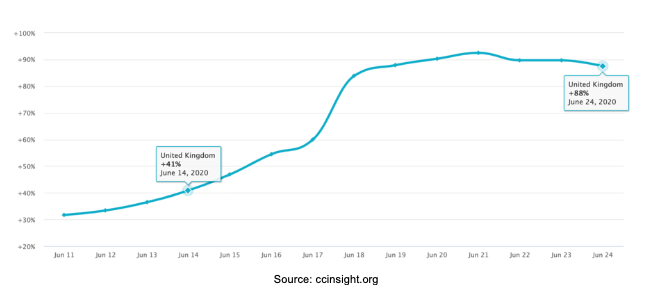Coronavirus and the subsequent lockdown have catalysed business change.
Businesses offering ‘non-essential’ services have been closed for several months. The consumers that could keep these enterprises alive are instead enduring an economic recession from the enforced comfort of their homes.
This situation has accelerated the speed at which businesses have evolved — or failed to do so. Many ill-equipped or simply unfortunate businesses have ceased to exist.
Those with more resources and/or a stroke of luck have, by necessity, quickly adapted to a new world order. More often than not, this means relying upon ecommerce to keep money coming in.
As a result, despite economic concerns and an inability to visit brick-and-mortar stores, there have been noticeable spikes in online sales throughout 2020.
Data from online commerce tracker ccinsight suggests that UK ecommerce revenue was up 88% year on year as of 24th June, rocketing from 41% just a fortnight earlier:

There are similar stories being reported all over the globe.
Meituan Dianping, China’s biggest on-demand delivery services firm, reported a 152% YOY rise in net profit, outstripping its losses for the March quarter of 2020. Across the Pacific in the USA, Walmart’s e-commerce sales were up 97% for Q2.
This is a result of some fairly seismic behavioural changes displayed by consumers. Analyst McKinsey suggests that over 40% of consumers have adopted new retail habits during lockdown that they will stick to post-pandemic.
Likewise, a poll from customer engagement platform Emarsys suggests that less than one in 10 shoppers will physically brave the high street this Black Friday, with almost a third (32%) instead browsing for deals online.
Demand for data
On a more positive note, this shift towards online shopping also means a dramatic increase in the amount of customer data being generated.
Every transaction, browsing session and account registration creates a digital footprint that organisations can use to inform their commercial and marketing strategies.
At the same time, customers are increasingly expecting a more personalised service from brands and retailers. Their data is a chance to hone a bespoke customer journey shaped around their behaviour and preference.
This means that the changes in customer behaviour, generating more and more data, is an opportunity for brands to better understand their user base, driving improvements in everything from customer experience (CX) to marketing strategy.
To do so, organisations need both the infrastructure to capture and organise the reams of data that they receive, and the tech stack to examine it and execute the required changes.
Programmed personality
As a result, many organisations are investing in ecommerce platforms that allow them to automate personalised interactions for their customers while organising their data stores internally.
Software or systems that can individualise promotions, recommendations and messaging for millions of customers are like gold dust to some brands. Add in AI to drive the personalisation element and they’re becoming more and more capable.
These platforms can also, importantly, enable organisations to centralise all of their data analysis, marketing campaign and customer outreach capabilities.
Some of the most successful business pivots during the coronavirus period are a result of streamlining in this way, reducing costs and streamlining internal processes by replacing many platforms with a single option.
Keep in touch
For other brands, new avenues of customer engagement are more of a priority.
There are some working hard to retain the customer as a physical touchpoint. RFID (Radio Frequency Identification) tags are one option, integrated into product labels or packaging to allow customers to access product and brand information with a tap of a smartphone.
The flexible, integrated circuits that make RFID tags mass-marketable are being popularised by manufacturers like PragmatIC. The RFID tag can provide a direct, physical link to promotions, competitions, refund/reordering, and even recycling advice.
Customers get the information that they need at the tap of a phone — with many appreciating the solidity of a physical interaction — while organisations open up a new point of data collection for customers.
**
Whether it’s the need to organise data or an appetite for more, retailers are using the coronavirus to evolve for the better.
The drive for efficiency has led to interesting changes in customer and business behaviour, and actions taken now could have a powerful positive impact for years to come.

